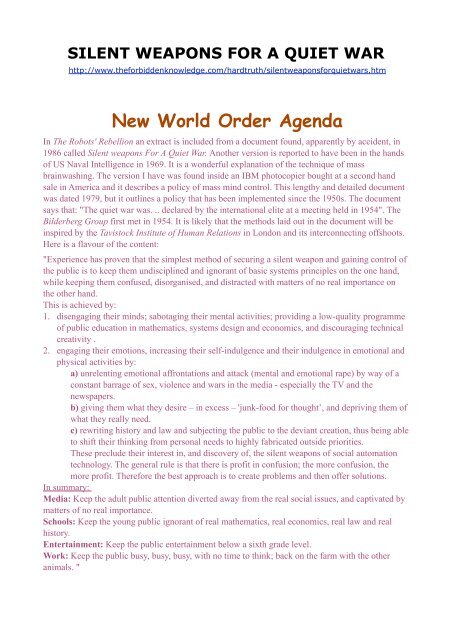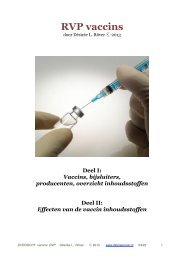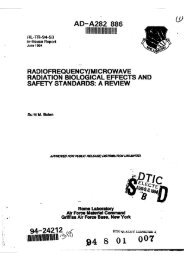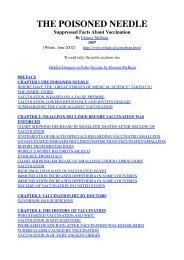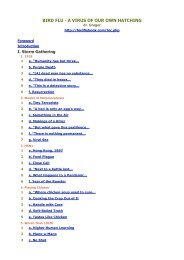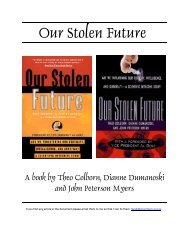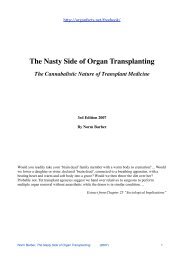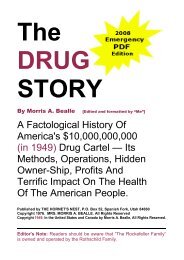Silent Weapons for a Quiet War
Silent Weapons for a Quiet War
Silent Weapons for a Quiet War
- No tags were found...
Create successful ePaper yourself
Turn your PDF publications into a flip-book with our unique Google optimized e-Paper software.
SILENT WEAPONS FOR A QUIET WARhttp://www.the<strong>for</strong>biddenknowledge.com/hardtruth/silentweapons<strong>for</strong>quietwars.htmNew World Order AgendaIn The Robots' Rebellion an extract is included from a document found, apparently by accident, in1986 called <strong>Silent</strong> weapons For A <strong>Quiet</strong> <strong>War</strong>. Another version is reported to have been in the handsof US Naval Intelligence in 1969. It is a wonderful explanation of the technique of massbrainwashing. The version I have was found inside an IBM photocopier bought at a second handsale in America and it describes a policy of mass mind control. This lengthy and detailed documentwas dated 1979, but it outlines a policy that has been implemented since the 1950s. The documentsays that: "The quiet war was. .. declared by the international elite at a meeting held in 1954". TheBilderberg Group first met in 1954. It is likely that the methods laid out in the document will beinspired by the Tavistock Institute of Human Relations in London and its interconnecting offshoots.Here is a flavour of the content:"Experience has proven that the simplest method of securing a silent weapon and gaining control ofthe public is to keep them undisciplined and ignorant of basic systems principles on the one hand,while keeping them confused, disorganised, and distracted with matters of no real importance onthe other hand.This is achieved by:1. disengaging their minds; sabotaging their mental activities; providing a low-quality programmeof public education in mathematics, systems design and economics, and discouraging technicalcreativity .2. engaging their emotions, increasing their self-indulgence and their indulgence in emotional andphysical activities by:a) unrelenting emotional affrontations and attack (mental and emotional rape) by way of aconstant barrage of sex, violence and wars in the media - especially the TV and thenewspapers.b) giving them what they desire – in excess – 'junk-food <strong>for</strong> thought’, and depriving them ofwhat they really need.c) rewriting history and law and subjecting the public to the deviant creation, thus being ableto shift their thinking from personal needs to highly fabricated outside priorities.These preclude their interest in, and discovery of, the silent weapons of social automationtechnology. The general rule is that there is profit in confusion; the more confusion, themore profit. There<strong>for</strong>e the best approach is to create problems and then offer solutions.In summary:Media: Keep the adult public attention diverted away from the real social issues, and captivated bymatters of no real importance.Schools: Keep the young public ignorant of real mathematics, real economics, real law and realhistory.Entertainment: Keep the public entertainment below a sixth grade level.Work: Keep the public busy, busy, busy, with no time to think; back on the farm with the otheranimals. "
This document is the doctrine adopted by the Policy Committee of the Bilderberg Groupduring its first known meeting in 1954.A copy found in 1969 was in the possession of Navel Intelligence.The following document, dated May 1979, was found on July 7, 1986, in an IBM copier thathad been purchased at a surplus sale.Top Secret<strong>Silent</strong> <strong>Weapons</strong> <strong>for</strong> a <strong>Quiet</strong> <strong>War</strong>An Introductory Programming ManualOperations ResearchTechnical ManualWELCOME ABOARDThis publication marks the 25th anniversary of the Third World <strong>War</strong>, called the "<strong>Quiet</strong> <strong>War</strong>,"being conducted using subjective biological warfare, fought with "silent weapons."This book contains an introductory description of this war, its strategies, and its weaponry.May 1979 #74-1120SECURITYIt is patently impossible to discuss social engineering or the automation of a society, i.e., theengineering of social automation systems (silent weapons) on a national or worldwide scalewithout implying extensive objectives of social control and destruction of human life, i .e.,slavery and genocide.This manual is in itself an analogue declaration of intent. Such a writing must be secured frompublic scrutiny. Otherwise, it might be recognized as a technically <strong>for</strong>mal declaration ofdomestic war. Furthermore, whenever any person or group of persons in a position of greatpower, and without the full knowledge and consent of the public, uses such knowledge andmethodology <strong>for</strong> economic conquest -- it must be understood that a state of domestic warfareexists between said person or group of persons and the public.The solution of today's problems requires an approach which is ruthlessly candid, with noagonizing over religious, moral, or cultural values.You have qualified <strong>for</strong> this project because of your ability to look at human society with coldobjectivity, and yet analyze and discuss your observations and conclusions with others ofsimilar intellectual capacity without a loss of discretion or humility. Such virtues are exercisedin your own best interest. Do not deviate from them.HISTORICAL INTRODUCTION<strong>Silent</strong> weapon technology has evolved from Operations Research (O.R.), a strategic andtactical methodology developed under the military management in England during World <strong>War</strong>II. The original purpose of Operations Research was to study the strategic and tacticalproblems of air and land defense with the objective of effective use of limited militaryresources against <strong>for</strong>eign enemies (i.e., logistics).It was soon recognized by those in positions of power that the same methods might be useful<strong>for</strong> totally controlling a society. But better tools were necessary.Social engineering (the analysis and automation of a society) requires the correlation of greatamounts of constantly changing economic in<strong>for</strong>mation (data), so a high speed computerizeddata processing system was necessary which could race ahead of the society and predict whensociety would arrive <strong>for</strong> capitulation.
Relay computers were too slow, but the electronic computer, invented in 1946 by J. PresperEckert and John W. Mauchly filled the bill.The next breakthrough was the development of the simplex method of linear programming in1947 by the mathematician, George B. Dantzig.Then, in 1948, the transistor, invented by J. Bardeen, W. H. Brattain, and W. Shockley,promised great expansion of the computer field by reducing space and power requirements.With these three inventions under their direction, those in positions of power stronglysuspected that it was possible <strong>for</strong> them to control the whole world with the push of a button.Immediately, the Rockefeller Foundation got in on the ground floor by making a four year grantto Harvard College, funding the Harvard economic research project <strong>for</strong> the study of thestructure of the American economy. One year later, in 1949, the United States Air Force joinedin.In 1952 the original great period terminated, and a high level meeting of the elite was held todetermine the next phase of social operations research. The Harvard project had been veryfruitful as is borne out by the publication of some of its results in 1953 suggesting thefeasibility of economic (social) engineering. (Studies in the Structure of the American Economy-- copyright 1953 by Wassily Leontief, International Sciences Press Inc., White Plains, NewYork.)Engineered in the last half decade of the 1940's, the new <strong>Quiet</strong> <strong>War</strong> machine stood, so tospeak,in sparkling gold plated hardware on the showroom floor by 1954.With the creation of the Maser in 1954, the promise of unlocking unlimited sources of fusionatomic energy from the heavy hydrogen in sea water and the consequent availability ofunlimited social power became a possibility only decades away.The combination was irresistible.The <strong>Quiet</strong> <strong>War</strong> was quietly declared by the international elite at a meeting held in 1954.Although the silent weapons system was nearly exposed 13 years later, the evolution of thenew weapon system has never suffered any major setbacks.This volume marks the 25th anniversary of the beginning of the <strong>Quiet</strong> <strong>War</strong>. Already thisdomestic war has had many victories on many fronts throughout the world.POLITICAL INTRODUCTIONIn 1954 it was well recognized by those in positions of authority that it was only a matter oftime, only a few decades, be<strong>for</strong>e the general public would be able to grasp and upset thecradle of power, <strong>for</strong> the very elements of the new silent weapon technology were as accessible<strong>for</strong> a public utopia as they were <strong>for</strong> providing a private utopia.The issue of primary concern that of dominance, revolved around the subject of the energysciences.ENERGYEnergy is recognized as the key to all activity on earth. Natural science is the study of thesources and control of natural energy, and social science, theoretically expressed aseconomics, is the study of the sources and control of social energy. Both are bookkeepingsystems; mathematics. There<strong>for</strong>e, mathematics is the primary energy science. And thebookkeeper can be king if the public can be kept ignorant of the methodology of thebookkeeping.All science is merely a means to an end. The means is knowledge. The end is control. Beyondthis remains only one issue, "who will be the beneficiary?".In 1954 this was the issue of primary concern. Although the so-called "moral Issues" wereraised, in view of the law of natural selection it was agreed that a nation or world of peoplewho will not use their intelligence are no better than animals who do not have intelligence.Such a people are beasts of burden and steaks on the table by choice and consent.
CONSEQUENTLY, in the interest of future world order, peace, and tranquility, it was decided toprivately wage a quiet war against the American public with an ultimate objective ofpermanently shifting the natural and social energy (wealth) of the undisciplined andirresponsible many into the hands of the self-disciplined, responsible, and worthy few.In order to implement this objective, it was necessary to create, secure, and apply newweapons which, as it turned out, were a class of weapons so subtle and sophisticated in theirprinciple of operation and public appearance as to earn <strong>for</strong> themselves the name 'silentweapons'.In conclusion, the objective of economic research, as conducted by the magnates of capital(banking) and the industries of commodities (goods) and services, is the establishment of aneconomy which is totally predictable and manipulatable.In order to achieve a totally predictable economy, the low class elements of the society mustbe brought under total control, i.e., must be house-broken, trained, and assigned a yoke andlong term social duties from a very early age, be<strong>for</strong>e they have an opportunity to question thepropriety of the matter. In order to achieve such con<strong>for</strong>mity, the lower class family unit mustbe disintegrated by a process of increasing preoccupation of the parents and the establishmentof government operated day care centers <strong>for</strong> the occupationally orphaned children.The quality of education given to the lower class must be of the poorest sort, so that the meatof ignorance isolating the inferior class from the superior class is and remainsincomprehensible to the inferior class. With such an initial handicap, even bright lower classindividuals have little if any hope of extricating themselves from their assigned lot in life. This<strong>for</strong>m of slavery is essential to maintaining some measure of social order, peace, andtranquillity <strong>for</strong> the ruling upper class.DESCRIPTIVE INTRODUCTION OF THE SILENT WEAPONEverything that is expected from an ordinary weapon is expected from a silent weapon by itscreators, but only in it its own manner of functioning.It shoots situations, instead of bullets; propelled by data processing, instead of chemicalreaction (explosion); originating from bits of data, instead of grains of gunpowder; from acomputer, instead of a gun; operated by a computer programmer, instead of marksman; underthe orders of a banking magnate, instead of a military general.It makes no obvious explosive noises, causes no obvious physical or mental injuries, and doesnot obviously interfere with anyone's daily social life.Yet it makes an unmistakable 'noise', causes unmistakable physical and mental damage, andunmistakably interferes with daily social life, i.e., unmistakable to a trained observer, one whoknows what to look <strong>for</strong>.The public cannot comprehend this weapon, and there<strong>for</strong>e cannot believe that they are beingattached and subdued by a weapon.The public might instinctively feel that something is wrong, but because of the technical natureof the silent weapon, they cannot express their feeling in a rational way, or handle the problemwith intelligence. There<strong>for</strong>e, they do not know how to cry <strong>for</strong> help, and do not know how toassociate with others to defend themselves against it.When a silent weapon is applied gradually to the public, the public adjusts/adapts to itspresence and learns to tolerate its encroachment on their lives until the pressure(psychological via economic) becomes too great and they crack up.There<strong>for</strong>e, the silent weapon is a type of biological war fare. It attacks the vitality, options, andmobility of the individuals of a society by knowing, understanding, manipulating, and attackingtheir sources of natural and social energy, and their physical, mental, and emotional strengthsand weaknesses.
THEORETICAL INTRODUCTION"Give me control over a nation's currency, and I care not who makes its laws."Mayer Amschel Rothschild (1743-1812)Today's silent weapons technology is an outgrowth of a simple idea discovered, succinctlyexpressed, and effectively applied by the quoted Mr. Mayor Amschel Rothschild. Mr. Rothschilddiscovered the missing passive component of economic theory known as economic inductance.He, of course, did not think of his discovery in these 20th century terms, and to be sure,mathematical analysis had to wait <strong>for</strong> the Second Industrial Revolution, the rise of the theoryof mechanics and electronics, and finally, the invention of the electronic computer be<strong>for</strong>e itcould be effectively applied in the control of the world economy.GENERAL ENERGY CONCEPTSIn the study of energy systems, there always appear three elementary concepts. These arepotential energy, kinetic energy, and energy dissipation. And corresponding to these concepts,there are three idealized, essentially pure physical counterparts, called passive components.In the science of physical mechanics, the phenomenon of of potential energy is associated witha physical property called elasticity or stiffness, and can be represented by a stretched spring.In electronic science, potential energy is stored in a capacitor instead of a spring. Thisproperty is called capacitance instead of elasticity or stiffness.In the science of physical mechanics, the phenomenon of kinetic energy is associated with aphysical property called inertia or mass and can be represented by a mass or a flywheel inmotion.In electronic science, kinetic energy is stored in an inductor (in a magnetic field) instead ofa mass. This property is called inductance instead of inertia.In the science of physical mechanics, the phenomenon of energy dissipation is associated witha physical property called friction or resistance, and can be represented by a dashpot or otherdevice which converts system energy into heat.In electronic science, dissipation of energy is per<strong>for</strong>med by an element called either aresistor or a conductor, the term 'resistor' being the one generally used to express theconcept of friction, and the term 'conductor' being generally used to describe a more idealdevice (e.g., wire) employed to convey electric energy efficiently from one location toanother. The property of a resistor or conductor is measured as either resistance orconductance, reciprocals.In economics these three energy concepts are associated with:Economic Capacitance -- Capital (money, stock/inventory, investments in building anddurables, etc.)Economic Conductance -- Goods (production flow coefficients)Economic Inductance -- Services (the influence of the population of industry on output).All of the mathematical theory developed in the study of one energy system, (e.g., mechanics,electronics, etc.) can be immediately applied in the study of any other energy system (e.g.,economics).MR. ROTHSCHILD'S ENERGY DISCOVERYWhat Mr. HYPERLINK "http://www.the<strong>for</strong>biddenknowledge.com/hardtruth/the_rothschild_bloodline.htm" Rothschild had discovered was the basic principle of power,influence, and control over people as applied to economics. That principle is "when you assumethe appearance of power, people soon give it to you".Mr. Rothschild had discovered that currency or deposit loan accounts had the requiredappearance of power that could be used to induce people (inductance, with peoplecorresponding to a magnetic field) into surrendering their real wealth in exchange <strong>for</strong> apromise of greater wealth (instead of real compensation). They would put up real collateral in
exchange <strong>for</strong> a loan of promissory notes. Mr. Rothschild found that he could issue more notesthan he had backing <strong>for</strong>, so long as he had someone's stock of gold as a persuader to show tohis customers.Mr. Rothschild loaned his promissory notes to individuals and to governments. These wouldcreate over-confidence. Then he would make money scarce, tighten control of the system, andcollect his collateral through the obligation of contracts. The cycle was then repeated. Thesepressures could be used to ignite a war. Then he would control the availability of currency todetermine who would win the war. That government which agreed to give him control of itseconomic system got his support. Collection of debts was guaranteed by economic aid to theenemy of the debtor. The profit derived from this economic methodology made Mr. Rothschildall the more wealthy and all the more able to extend his wealth. He found that the public greedwould allow currency to be printed by government order beyond the limits (inflation) ofbacking in precious metal or the production of goods and services (gross national product,GNP).APPARENT CAPITAL AS "PAPER" INDUCTORIn this structure, credit, presented as a pure circuit element called "currency", has theappearance of capital, but is, in fact, negative capital. Hence, it has the appearance of service,but is, in fact, indebtedness or debt. It is there<strong>for</strong>e an economic inductance instead of aneconomic capacitance, and if balanced in no other way, will be balanced by the negation ofpopulation (war, genocide). The total goods and services represents real capital called thegross national product, and currency may be printed up to this level and still representeconomic capacitance; but currency printed beyond this level is subtractive, represents theintroduction of economic inductance, and constitutes notes of indebtedness. <strong>War</strong> is there<strong>for</strong>ethe balancing of the system by killing the true creditors (the public which we have taught toexchange true value <strong>for</strong> inflated currency) and falling back on whatever is left of the resourcesof nature and the regeneration of those resources.Mr. Rothschild had discovered that currency gave him the power to rearrange the economicstructure to his own advantage,, to shift economic inductance to those economic positionswhich would encourage the greatest economic instability and oscillation.The final key to economic control had to wait until there was sufficient data and high speedcomputing equipment to keep close watch on the economic oscillations created by priceshocking and excess paper energy credits -- (paper inductance/inflation).BREAKTHROUGHThe aviation field provided the greatest evolution in economic engineering by way of themathematical theory of shock testing. In this process, a projectile is fired from an airframe onthe ground and the impulse of the recoil is monitored by vibration transducers connected tothe airframe and wired to chart recorders. By studying the echoes or reflections of the recoilimpulse in the airframe, it is possible to discover critical vibrations in the structure of theairframe which either vibrations of the engine or aeolian vibrations of the wings, or acombination of the two, might rein<strong>for</strong>ce resulting in a reconant self-destruction of the airframein flight as an aircraft. From the standpoint of engineering, this means that the strengths andweaknesses of the structure of the airframe in terms of vibrational energy can be discoveredand manipulated.APPLICATION IN ECONOMICSTo use this method of airframe shock testing in economic engineering, the prices ofcommodities are shocked, and the public consumer reaction is monitored. The resulting echoesof the economic shock are interpreted theoretically by computers and the psycho-economicstructure of the economy is thus discovered. It is by this process that partial differential anddifference matrices are discovered that define the family household and make possible itsevolution as an economic industry (dissipative consumer structure). Then the response of thehousehold to future shocks can be predicted and manipulated, and society becomes a well
egulated animal with its reins under the control of a sophisticated computer-regulated socialenergy bookkeeping system.Eventually every individual element of the structure comes under computer control through aknowledge of personal preferences, such knowledge guaranteed by computer association ofconsumer preferences (universal product code -- UPC -- zebra stripe pricing codes onpackages) with identified consumers (identified via association with the use of a credit cardand later a permanent 'tattooed' body number invisible under normal ambient illumination.SUMMARYEconomics is only a social extension of a natural energy system. It, also, has its three passivecomponents. Because of the distribution of wealth and the lack of communication andconsequent lack of data, this field has been the last energy field <strong>for</strong> which a knowledge ofthese three passive components has been developed.Since energy is the key to all activity on the face of the earth, it follows that in order to attaina monopoly of energy, raw materials, goods, and services and to establish a world system ofslave labor, it is necessary to have a first strike capability in the field of economics. In order tomaintain our position, it is necessary that we have absolute first knowledge of the science ofcontrol over all economic factors and the first experience at engineering the world economy.In order to achieve such sovereignty, we must at least achieve this one end: that the publicwill not make either the logical or mathematical connection between economics and the otherenergy sciences or learn to apply such knowledge.This is becoming increasingly difficult to control because more and more businesses aremaking demands upon their computer programmers to create and apply mathematical models<strong>for</strong> the management of those businesses.It is only a matter of time be<strong>for</strong>e the new breed of private programmer/economists will catchon to the far reaching implications of the work begun at Harvard in 1948. The speed withwhich they can communicate their warning to the public will largely depend upon how effectivewe have been at controlling the media, subverting education, and keeping the publicdistracted with matters of no real importance. (TV, soccer, games, porn).THE ECONOMIC MODELEconomics, as a social energy science has as a first objective the description of the complexway in which any given unit of resources is used to satisfy some economic want. (LeontiefMatrix) The first objective, when it is extended to get the most product from the least orlimited resources, comprises that objective of general military) and industrial logistics knownas Operations Research. (See simplex method of linear programming.)The Harvard Economic Research Project (1948-) was an extension of World <strong>War</strong> IIOperations Research. Its purpose was to discover the science of controlling an economy; atfirst the American economy, and then the world economy. It was felt that with sufficientmathematical foundation and data, it would be nearly as easy to predict and control the trendof an economy as to predict and control the trajectory of a projectile. Such as proven to be thecase. Moreover, the economy has been trans<strong>for</strong>med into a guided missile on target.The immediate aim of the Harvard project was to discover the economic structure, what <strong>for</strong>ceschange that structure, how the behavior of the structure can be predicted, and how it can bemanipulated. What was needed was a well organized knowledge of the mathematicalstructures and interrelationships of investment, production, distribution, and consumption. Tomake a short story of it all, it was discovered than an economy obeyed the same, laws aselectricity and that all of the mathematical theory and practical and computer know-howdeveloped <strong>for</strong> the electronic field could be directly applied in the study of economics. Thisdiscovery was not openly declared, and its more subtle implications were and are kept aclosely guarded secret, <strong>for</strong> example that in an economic model, human life is measured indollars, and that the electric spark generated when opening a switch connected to an activeinductor in mathematically analogous to the initiation of a war.
The greatest hurdle which theoretical economists faced was the accurate description of the
household as an industry. This is a challenge, because consumer purchases are a matter ofchoice which in turn is influenced by income, price, and other economic factors.This hurdle was cleared in an indirect and statistically approximate way by an application ofshock testing to determine the current characteristics, called current technical coefficients, of ahousehold industry. HYPERLINK "http://www.the<strong>for</strong>biddenknowledge.com/hardtruth/whygascosts2_00pergallon.htm" Why GAS Costs $2.00 Per GallonFinally, because problems in theoretical economics can be translated very easily into problemsin theoretical electronics, and the solution translated back again, it follows that only a book oflanguage translation and concept definition needed to be written <strong>for</strong> economics. The remaindercould be gotten from standard works on mathematics and electronics. This makes thepublication of books on advanced economics unnecessary, and greatly simplifies projectsecurity.INDUSTRIAL DIAGRAMSAn ideal industry is defined as a device which receives value from other industries in several<strong>for</strong>ms and converts it into one specific product <strong>for</strong> sales and distribution to other industries. Ithas several inputs and one output. What the public normally thinks of as one industry is reallyan industrial complex where several industries under one roof produce one or more products.The flow of product from industry #1 (supply) to industry #2 (demand) is denoted by 112. Thetotal flow out of industry 'K' is denoted by I k . (sales, etc.)A node is a symbol of collection and distribution of flow. Node #3 receives from industry #3and distributes to industries #1 through #3. If industry #3 manufactures chairs, then a flowfrom Industry #3 back to industry #3 simply indicates that industry #3 is using part of its ownoutput product, <strong>for</strong> example, as office furniture. There<strong>for</strong>e, the flow may be summarized bythe equations:THREE INDUSTRIAL CLASSESIndustries fell into three categories or class by type of output.Class #1 - Capital (resources)Class #2 - Goods (commodities or use - dissipative)Class #3 - Services (action of population)Class # 1 Industries exist at three levels(1) Nature - sources of energy and raw materials.(2) Government - printing of currency equal to gross national product(GNP), and extension of currency in excess of GNP.(3) Banking - loaning of money <strong>for</strong> interest, and extension(counterfeiting) of economic value through deposit loan account -inflation.Class # 2 industries exist as producers of tangible or consumer (dissipated) products. This sortof activity is usually recognized and labelled by the public as an 'industry'.Class # 3 industries are those which have service rather than a tangible product as theiroutput. These industries are called (1) households, and (2) governments. Their output ishuman activity of a mechanical sort, and their basis is population.AGGREGATIONThe whole economic system can be represented by a three industry model if one allows thenames of the outputs to be (1) capital, (2) goods, and (3) services. The problem with thisrepresentation is that it would not show the influence of, say, the textile industry on theferrous metal industry. This is because both the textile industry and the ferrous metal industry
would be contained within a single classification called the 'goods industry' and by this processof combining or aggregating these two industries under one system block they would lose theireconomic individuality.THE E-MODELA national economy consists of simultaneous flows of production, distribution, consumption,and investment. If all of these elements including labor and human functions are assigned anumerical value in like units of measure, say, 1939 dollars, on this flow can be furtherrepresented by a current flow in an electronic circuit, and its behavior can be predicted andmanipulated with useful precision.The three ideal passive energy components of electronics, the capacitor, the resistor, and theinductor correspond to the three ideal passive energy components of economics called thepure industries of capital, goods, and services, resp..Economic capacitance represents the storage of capital in one <strong>for</strong>m or another.Economic conductance represents the level of conductance of materials <strong>for</strong> the production ofgoods.Economic inductance represents the inertia of economic value in motion. This is a populationphenomenon known as services.ECONOMIC INDUCTANCEAn electrical inductor (e.g., a coil of wire) has an electric current as its primary phenomenonand a magnetic field as its secondary phenomenon (inertia). Corresponding to this, aneconomic inductor has a flow of economic value as its primary phenomenon and a populationfield as its secondary phenomenon of inertia. When the flow of economic value (e.g., money)diminishes, the human population field collapses in order to keep the economic value (money)flowing (extreme case - war).The public inertia is a result of consumer buying habits, expected standard of living, etc., andis generally a phenomenon of self-preservation.PopulationINDUCTIVE FACTORS TO CONSIDERmagnitude of the economic activities of the government.the method of financing these government activities (see Peter-Paul Principle-inflation of thecurrency)CHARGEFLOW/CURRENTMOTIVATING FORCECONDUCTANCECAPITANCETRANSLATION(A few examples will be given.)-- coulombs-- dollars (1939).-- amperes (coulombs per second)-- dollars of flow per year.-- volts -- dollars (output) demand.-- amperes per volt.-- dollars of flow per year per dollar demand.-- coulombs per volt.-- dollars of production inventory/stock per dollar demand.
TIME-FLOW RELATIONSHIPS AND SELF-DESTRUCTIVE OSCILLATIONSAn ideal industry may be symbolized electronically in various ways. The simplest way is torepresent a demand by a voltage and a supply by a current. When this is done, therelationship between the two becomes what is called an admittance, which can result fromthree economic factors: (1) hindsight flow, 2) present flow, and (3) <strong>for</strong>esight flow.Foresight flow is the result of that property of living entities to cause energy (food) to bestored <strong>for</strong> a period of low energy (e.g., a winter season). It consists of demands made upon aneconomic system <strong>for</strong> that period of low energy (winter season). In a production industry ittakes several <strong>for</strong>ms, one of which is known as production stock or inventory. In electronicsymbology this specific industry demand (a pure capital industry) is represented bycapacitance and the stock or resource is represented by a stored charge. Satisfaction of anindustry demand suffers a lag because of the loading effect of inventory priorities.Present flow ideally involves no delays. It is, so to speak, input today <strong>for</strong> output today, a 'handto mouth' flow. In electronic symbology, this specific industry demand (a pure use industry) isrepresented by a conductance which is then a simple economic valve (a dissipative element).Hindsight flow is known as habit or inertia. In electronics, this phenomenon is thecharacteristic of an inductor (economic analogue = a pure service industry) in which a currentflow (economic analogue = flow of money) creates a magnetic field (economic analogue =active human population) which, if the current (money flow) begins to diminish, collapses(war) to maintain the current (flow of money -- energy).Other large alternatives to war as economic inductors or economic flywheels are an openendedsocial welfare program, or enormous (but fruitful) open-ended space program.The problem with stabilizing the economic system is that there is too much demand on accountof (1) too much greed and (2) too much population.This creates excessive economic inductance which can only be balanced with economiccapacitance (true resources or value - e.g. in goods or services). The social welfare program isnothing more than an open-ended credit balance system which creates a false capital industryto give non-productive people a roof over their heads and food in their stomachs. This can beuseful, however, because the recipients become state property, in return <strong>for</strong> the 'gift' , astanding array <strong>for</strong> the elite. For he who pays the piper, picks the tune. Those who get hookedon the economic drug, must go to the elite <strong>for</strong> a fix. In this, the method of introducing largeamounts of stabilizing capacitance is by borrowing on the future 'credit' of the world. This is afourth law of motion -- onset, and consists of per<strong>for</strong>ming an action and leaving the systembe<strong>for</strong>e the reflected reaction returns to the point of action -- a delayed reaction. The means ofsurviving the reaction is by changing the system be<strong>for</strong>e the reaction can return. By thismeans, politicians become popular in their own time and the public pays <strong>for</strong> it later. In fact themeasure of such a politician is the delay time. The same thing is achieved by a government byprinting money beyond the limit of the gross national product, an economic process calledinflation. This puts a large quantity of money into the hands of the public and maintains abalance against their greed, creates a false self-confidence in them and, <strong>for</strong> a while, stays thewolf from the door.They must eventually resort to war to balance the account, because war ultimately is merelythe act to keep the responsibility and blood off the public conscience. (See section on consentfactors and social-economic structuring.)If the people really cared about their fellow man, they would control their appetites (greed,procreation, etc.) so that they would not have to operate on a credit or welfare social systemwhich steals from this worker to satisfy the bum.Since most of the general public will not exercise restraint, there are only two alternatives toreduce the economic inductance of the system.(1) Let the populace bludgeon each other to death in war, which will only result in a totaldestruction of the living earth.(2) Take control of the world by the use of economic 'silent weapons' in a <strong>for</strong>m of 'quietwarfare', and reduce the economic inductance of the world to a safe level by a process ofbenevolent slavery and genocide.
The latter option has been taken as the obviously better option. At this point it should becrystal clear to the reader why absolute secrecy about the silent weapons is necessary. Thegeneral public refuses to improve its own mentality and its faith in its fellow man. It hasbecome a herd of proliferating barbarians, and, so' to speak, a blight upon the fate of theearth. They do not care enough about economic science to learn why they have not been ableto avoid war despite religious morality, and their religious or self-gratifying refusal to deal withearthly problems renders the solution of the earthly problem unreachable by them. It is left tothose few who are truly willing to think and survive as the fittest to survive, to solve theproblem <strong>for</strong> themselves as the few who really care. Otherwise, exposure of the silent weaponwould destroy our only hope of preserving the seed of future true humanity.THE HOUSEHOLD INDUSTRYThe industries of finance (banking), manufacturing, and government, real counterparts of thepure industries of capital, goods, and services, are easily defined because they are generallylogically structured. Because of this their processes can be described mathematically and theirtechnical coefficients can be easily deduced. This, however, is not the case with the serviceindustry known as the household industry.HOUSEHOLD MODELSWhen the industry flow diagram is represented by a 2-block system of households on the rightand all other industries on the left, the following results.(labor, etc.)The arrows from left to right labeled A, B, C, etc., denote flow of economic value from theindustries in the left hand block to the industry in the right hand block called 'households'.These may be thought of as the monthly consumer flows of the following commodities. A -alcoholic beverages, B - beef, C - coffee, ..., U - unknown, etc..The problem which a theoretical economist faces is that the consumer preferences of anyhousehold is not easily predictable and the technical coefficients of any one household tend tobe a non-linear, very complex, and variable function income, prices, etc.Computer in<strong>for</strong>mation derived from the use of the universal product code in conjunction withcredit card purchase as an individual household identifier could change this state of affairs. Butthe U.P.C. method is not yet available on a national or even a significant regional scale. Tocompensate <strong>for</strong> this data deficiency, an alternate indirect approach of analysis has beenadopted known as economic shock testing. This method, widely used in the aircraftmanufacturing industry develops an aggregate statistical sort of data.Applied to economics, this means that all of the households in one region or in the wholenation are studied as a group or class rather than individually, and the mass behavior ratherthan individual behavior is used to discover useful estimates of the technical coefficientsgoverning the economic structure of the hypothetical single household industry.Notice in the industry flow diagram that the values <strong>for</strong> the flows A,B,C, etc., are accessible tomeasurement in terms of selling prices and total sales of commodities.One method of evaluating the technical coefficients of the household industry depends uponshocking the prices of a commodity and noting the changes in the sales of all of thecommodities.ECONOMIC SHOCK TESTINGIn recent times, the application of Operations Research to the study of the public economy hasbeen obvious <strong>for</strong> anyone who understands the principles of shock testing.In the shock testing of an aircraft airframe, the recoil impulse of firing a gun mounted on thatairframe causes shock waves in that structure which tell aviation engineers the conditionsunder which parts of the airplane or the whole airplane or its wings will start to vibrate orflutter like a guitar string, a flute reed, or a tuning <strong>for</strong>k, and disintegrate or fall apart in flight.
Economic engineers achieve the same result in studying the behavior of the economy and theconsumer public by carefully selecting a staple commodity such as beef, coffee, gasoline, orsugar and then causing a sudden change or shock in its price or availability, thus kickingeverybody's budget and buying habits out of shape.They then observe the shock waves which result by monitoring the changes in advertising,prices, and sales of that and other commodities.The objective of such studies is to acquire know-how to set the public economy into apredictable state of motion or change, even a controlled self-destructive state of motion whichwill convince the public that certain "expert" people should take control of the money systemand reestablish security (rather than liberty and justice) <strong>for</strong> all. When the subject citizens arerendered unable to control their financial affairs, they of course, become totally enslaved, asource of cheap labor.Not only the prices of commodities, but also the availability of labor can be used as the meansof shock testing. Labor strikes deliver excellent test shocks to an economy, especially in thecritical service areas of trucking (transportation), communication, public utilities (energy,water, garbage collection), etc.By shock testing, it is found that there is a direct relationship between the availability ofmoney flowing in an economy and the psychological outlook and response of masses of peopledependent upon that availability.For example, there is a measurable, quantitative relationship between the price of gasoline,and the probability that a person would experience a headache, feel a need to watch a violentmovie, smoke a cigarette, or go to a tavern <strong>for</strong> a mug of beer.It is most interesting that, by observing and measuring the economic modes by which thepublic tries to run from their problems and escape from reality, and by applying themathematical theory of Operations Research, it is possible to program computers to predict themost probable combination of created events (shocks) which will bring about a completecontrol and subjugation of the public through a subversion of the public economy (by shakingthe plum tree).INTRODUCTION TO THE THEORY OF ECONOMIC SHOCK TESTINGLet the prices and total sales of commodities be given and symbolized as follows.Let us assume a simple economic model in which the total number of important (staple)commodities are represented as beef, gasoline, and an aggregate of all other staplecommodities which we will call the hypothetical miscellaneous staple commodity 'M'. (e.g., M isan aggregate of C, S, T, U, etc..)INTRODUCTION TO ECONOMIC AMPLIFIERSEconomic amplifiers are the active components of economic engineering. The basiccharacteristic of any amplifier, (mechanical, electrical, or economic) is that it receives an inputcontrol signal and delivers energy from an independent energy, source to a specified outputterminal in a predictable relationship to that input control signal.The simplest <strong>for</strong>m of economic amplifier is a device called advertising.If a person is spoken to by a T.V. advertiser as if he were a twelve year old, then, due tosuggestibility, he will, with a certain probability, respond or react to that suggestion with theuncritical response of a twelve year old and will reach into his economic reservoir and deliverits energy to buy that product on impulse when he passes it in the store.An economic amplifier may have several inputs and outputs. Its response might beinstantaneous or delayed. Its circuit symbol might be a rotary switch if its options areexclusive, qualitative, 'go' or 'no go', or it might have its parametric input/output relationshipsspecified by a matrix with internal energy sources represented.Whatever its <strong>for</strong>m might be, its purpose is to govern the flow of energy from a source to anoutput sink in direct relationship to an input control signal. For this reason, it is called an activecircuit element or component.
Economic Amplifiers fall into classes called strategies, and in comparison with electronicamplifiers, the specific internal functions or an economic amplifier are called logistical insteadof electrical.There<strong>for</strong>e, economic amplifiers not only deliver power gain, but also, in effect, are used tocause changes in the economic circuitry.In the design of an economic amplifier we must have some idea of at least five functions,which are:(1) the available input signals,(2) the desired output control objectives,(3) the strategic objective,(4) the available economic power sources,(5) the logistical options.The process of defining and evaluating these factors and incorporating the economic amplifierinto an economic system has been popularly called game theory.The design of an economic amplifier begins with a specification of the power level of theoutput, which can range from personal to national. The second condition is accuracy ofresponse, i.e., how accurately the output action is a function of the input commands. High gaincombined with strong feedback helps to deliver the required precision. Most of the error will bein the input data signal. Personal input data tends to be specific, while national input datatends to be statistical.SHORT LIST OF INPUTSQuestions to be answered:(1) what (3) where (5) why(2) when (4) how (6) whoGeneral sources of in<strong>for</strong>mation:(1) telephone taps (3) analysis of garbage(2) surveillance (4) behavior of children in schoolStandard of living by:(1) food (3) shelter(2) clothing (4) transportationSocial contacts:(1) telephone - itemized record of calls(2) family - marriage certificate, birth certificates, etc.(3) friends, associates, etc.(4) memberships in organizations(5) political affiliationPersonal buying habits, i.e.,Personal consumer preferences:Assets:(1) checking accounts(2) credit card purchasesTHE PERSONAL PAPER TRAIL(3) ' tagged' credit card purchases - the credit card purchase of productsbearing the U.P.C. (Universal Product Code)
Liabilities:(1) checking accounts (5) automobile, etc.(2) savings accounts (6) safety deposit at bank(3) real estate (7) stock market(4) business(1) creditors (3) loans(2) enemies (see legal) (4) consumer creditGovernment sources (ploys)*:(1) Welfare (4) doles(2) Social Security (5) grants(3) U.S.D.A. surplus food (6) subsidiesGovernment sources (via intimidation)(1) Internal Revenue Service(2) OSHA(3) Census(4) etc.* Principle of this ploy -- the citizen will almost always make the collection of in<strong>for</strong>mation easyif he can operate on the 'free sandwich principle' of 'eat now, and pay later'.Other Government sources -- surveillance of U.S. Mail.Strengths and weaknesses:(1) activities (sports, hobbies, etc.)HABIT PATTERNS -- PROGRAMMING(2) see 'legal' (fear, anger, etc. - crime record)(3) hospital records (drug sensitivities, reaction to pain, etc.)(4) psychiatric records (fears, angers, disgusts, adaptability, reactions tostimuli, violence, suggestibility or hypnosis, pain, pleasure, love and sex)Methods of coping -- adaptability -- behavior:(1) consumption of alcohol(2) consumption of drugs(3) entertainment(4) religious factors influencing behavior(5) other methods of escaping from reality.Payment modus operandi (MO) -- pay on time, etc.:(1) payment of telephone bills(2) energy purchases (electric, gas...)(3) water purchases(4) repayment of loans(5) house payments(6) automobile payments(7) payments on credit cards
Political sensitivity:(1) beliefs (3) position (5) projects/activities(2) contacts (4) strengths/weaknessesLegal inputs - behavior control(Excuses <strong>for</strong> investigation, search, arrest, or employment of <strong>for</strong>ce to modify behavior.)(1) court reports (4) reports made topolice(2) police records - NCIC (5) insurancein<strong>for</strong>mation(3) driving record (6) anti-establishmentacquaintancesNATIONAL INPUT INFORMATIONBusiness sources (via I.R.S., etc.):(1) prices of commodities(2) sales(3) investments in(a) stocks/inventory(b) production tools and machinery(c) buildings and improvements(d) the stock marketBanks and credit bureaus:(1) credit in<strong>for</strong>mation(2) payment in<strong>for</strong>mationMiscellaneous Sources:(1) polls and surveys(2) publications(3) telephone records(4) energy and utility purchasesSHORT LIST OF OUT PUTSOutputs - create controlled situations- manipulation of the economy. hence society- control by control of compensation and losses.Sequence:(1) allocates opportunities.(2) destroys opportunities.(3) controls the economic industry.(4) controls the availability of raw materials(5) controls capital.(6) controls bank rates.(7) controls the inflation of the currency.(8) controls the possession of property.
(9) controls the industrial capacity.(10) controls manufacturing.(11) controls the availability of goods (commodities).(12) controls the prices of commodities.(13) controls services, the labor <strong>for</strong>ce, etc.(14) controls payments to government officials.(15) controls the legal functions(16) controls the personal data file uncorrectable - by the partyslandered.(17) controls advertising.(18) controls media content.(19) controls material available <strong>for</strong> T.V. viewing.(20) disengages attention from real issues.(21) engages emotions.(22) creates disorder, chaos, and insanity.(23) controls design of more probing tax <strong>for</strong>ms.(24) controls surveillance.(25) controls the storage of in<strong>for</strong>mation.(26) develops psychological analyses and profiles of individuals.(27) controls legal functions (repeat of 15).(28) controls sociological factors.(29) controls health options.(30) preys on weaknesses.(31) cripples strengths.(32) leaches wealth and substance.DIVERSION, THE PRIMARY STRATEGYExperience has proven that the simplest method of securing a silent weapon and gainingcontrol of the public is to keep the public undisciplined and ignorant of basic systems principleson the one hand, while keeping them confused, disorganized, and distracted with matters of noreal importance on the other hand.This is achieved by:(1) Disengaging their minds, sabotaging their mental activities, by providing a low qualityprogram of public education in mathematics, logic, systems design, and economics, and bydiscouraging technical creativity.(2) Engaging their emotions, increasing their self-indulgence and their indulgence in emotionaland physical activities, by:(a) unrelenting emotional affrontations and attacks (mental andemotional rape) by way of a constant barrage of sex, violence, and warsin the media - especially the T.V. and the newspapers.(b) giving them what they desire - in excess - "junk food <strong>for</strong> thought"and depriving them of what they really need.(3) Rewriting history and law and subjecting the public to the deviant creation, thus being ableto shift their thinking from personal needs to highly fabricated outside priorities.These preclude their interest in and discovery of the silent weapons of social automationtechnology.
The general rule is that there is profit in confusion; the more confusion, the more profit.There<strong>for</strong>e, the best approach is to create problems and then offer the solutions.DIVERSION SUMMARYMEDIA: Keep the adult public attention diverted away from the real social issues, andcaptivated by matters of no real importance.SCHOOLS: Keep the young public ignorant of real mathematics, real economics, reallaw, and real history.ENTERTAINMENT: Keep the public entertainment below a sixth grade level.WORK: Keep the public busy, busy, busy, with no time to think; back on the farmwith the other animals.CONSENT, THE PRIMARY VICTORYA silent weapon system operates upon data obtained from a docile public by legal (but notalways lawful) <strong>for</strong>ce. Much in<strong>for</strong>mation is made available to silent weapon systemsprogrammers through the Internal Revenue Service . (See "Studies In The Structure Of TheAmerican Economy" <strong>for</strong> an I.R.S. source list.) This in<strong>for</strong>mation consists of the en<strong>for</strong>ced deliveryof well organized data contained in federal and state tax <strong>for</strong>ms collected, assembled, andsubmitted by slave labor provided by taxpayers and employers. Furthermore, the number ofsuch <strong>for</strong>ms submitted to the I.R.S. is a useful indicator of public consent, an important factorin strategic decision making. Other data sources are given in the "Short List Of Inputs.Consent Coefficients: numerical feedback indicating victory status. Psychological basis:When the government is able to collect tax and seize private propertywithout just compensation, it is an indication that the public is ripe <strong>for</strong>surrender and is consenting to enslavement and legal encroachment. Agood and easily quantified indicator of harvest time is the number ofpublic citizens who pay income tax.AMPLIFICATION ENERGY SOURCESThe next step in the process of designing as economic amplifier is discovering the energysources. The energy sources which support any primitive economic system are, of course, asupply of raw materials, and the consent of the people to labor and consequently assume acertain rank, position, level, or class in the social structure; i.e., to provide labor at variouslevels in the pecking order.Each class, in guaranteeing its own level of income, controls the class immediately below it,hence preserves the class structure. This provides stability and security, but also governmentfrom the top.As time goes on and communication and education improve, the lower class elements of thesocial labor structure become knowledgeable and envious of the good things that the upperclass members have. They also begin to attain a knowledge of energy systems and the abilityto en<strong>for</strong>ce their rise through the class structure.This threatens the sovereignty of the elite.If this rise of the lower classes can be postponed long enough, the elite can achieve energydominance, and labor by consent no longer will hold a position of an essential economic energysource.Until such energy dominance is absolutely established, the consent of people to labor and letothers handle their affairs must be taken into consideration, since failure to do so could causethe people to interfere in the final transfer of energy sources to the control of the elite.It is essential to recognize that at this time, public consent is still an essential key to therelease of energy in the process of economic amplification.There<strong>for</strong>e, consent as an energy release mechanism will now be considered.
LOGISTICSThe successful application of a strategy requires a careful study of inputs, outputs, the strategyconnecting the inputs and the outputs, and the available energy sources to fuel the strategy.This study is called logistics.A logistical problem is studied at the elementary level first, and then levels of greatercomplexity are studied as a synthesis of elementary factors.This means that a given system is analyzed, i.e., broken down into its sub-systems, and thesein turn are analyzed, until, by this process, one arrives at the logistical 'atom', the individual.This is where the process of syntheses properly begins, at the time of the birth of theindividual.THE ARTIFICIAL WOMBFrom the time a person leaves its mother's womb, its every ef<strong>for</strong>t is directed toward building,maintaining, and withdrawing into artificial wombs, various sorts of substitute protectivedevices or shells.The objective of these artificial wombs is to provide a stable environment <strong>for</strong> both stable andunstable activity; to provide a shelter <strong>for</strong> the evolutionary processes of growth, and maturity -i.e., survival; to provide security <strong>for</strong> freedom and to provide defensive protection <strong>for</strong> offensiveactivity.THE POLITICAL STRUCTURE OF A NATION - DEPENDENCYThe primary reason why the individual citizens of a country create a political structure is asubconscious wish or desire to perpetuate their own dependency relationship of childhood.Simply put, they want a human god to eliminate all risk from their life, pat them on the head,kiss their bruises, put a chicken on every dinner table, clothe their bodies, tuck them into bedat night, and tell them that everything will be alright when they wake up in the morning.This public demand is incredible, so the human god, the political, meets incredibility withincredibility by promising the world and delivering nothing. So who is the bigger liar?, thepublic?, or the 'godfather'?This public behavior is surrender born of fear, laziness and expediency. It is the basis of thewelfare state as a strategic weapon, useful against a disgusting public.ACTION/OFFENSEMost people want to be able to subdue and/or kill other human beings which disturb their dailylives, but they do not want to have to cope with the moral and religious issues which such anovert act on their part might raise. There<strong>for</strong>e, they assign the dirty work to others (includingtheir own children) so as to keep the blood off their own hands. They rave about the humanetreatment of animals and then sit down to a delicious hamburger from a whitewashedslaughterhouse down the street and out of sight. But even more hypocritical, they pay taxes tofinance a professional association of hit men collectively called politicians, and then complainabout corruption in government.RESPONSIBILITYAgain, most people want to be free to do things (to explore, etc.) but they are afraid to fail.The fear of failure is manifested in irresponsibility, and especially in delegating those personalresponsibilities to others where success is uncertain or carries possible or created liabilities(law) which the person is not prepared to accept.
They want authority (root word - 'author'), but they will not accept responsibility or liability.They hire politicians to face reality <strong>for</strong> them.SUMMARYThe people hire the politicians so that the people can:1. obtain security without managing it.2. obtain action without thinking about it.3. inflict theft, injury, and death upon others without having to contemplate either life ordeath.4. avoid responsibility <strong>for</strong> their own intentions.5. obtain the benefits of reality and science without exerting themselves in the discipline offacing or learning either of these things.They give the politicians the power to create and manage a war machine to:1. provide <strong>for</strong> the survival of the NATION/WOMB.2. prevent encroachment of anything of anything upon the NATION/WOMB.3. destroy the enemy who threatens the NATION/WOMB.4. destroy those citizens of their own country who do not con<strong>for</strong>m <strong>for</strong> the sake of stability ofthe NATION/WOMB.Politicians hold many quasi-military jobs, the lowest being the police which are soldiers, theattorneys and the C.P.A.s next who are spies and saboteurs (licensed), and the judges whoshout the orders and run the closed union military shop <strong>for</strong> whatever the market will bear. Thegenerals are industrialists. The 'presidential' level of commander-in-chief is shared by theinternational bankers. The people know that they have created this farce and financed it withtheir own taxes (consent), but they would rather knuckle under than be the hypocrite.Thus, a nation becomes divided into two very distinct parts, a DOCILE SUB-NATION and aPOLITICAL SUB-NATION. The political sub-nation remains attached to the docile sub-nation,tolerates it, and leaches its substance until it grows strong enough to detach itself and devourits parent.SYSTEM ANALYSISIn order to make meaningful computerized economic decisions about war, the primaryeconomic flywheel, it is necessary to assign concrete logistical values to each element of thewar structure -- personnel and material alike.This process begins with a clear and candid description of the sub-systems of such a structure.THE DRAFT (As military service)Few ef<strong>for</strong>ts of human behavior modification are more remarkable or more effective than that ofthe socio-military institution known as the draft. A primary purpose of a draft or other suchinstitution is to instill, by intimidation, in the young males of a society the uncritical convictionthat the government is omnipotent. He is soon taught that a prayer is slow to reverse what abullet can do in an instant. Thus, a man trained in a religious environment <strong>for</strong> eighteen yearsof his life can, by this instrument of the government, be broken down, be purged of hisfantasies and delusions in a matter of mere months. Once that conviction is instilled, all elsebecomes easy to instill.Even more interesting is the process by which a young man's parents, who purportedly lovehim, can be induced to send him off to war to his death. Although the scope of this work willnot allow this matter to be expanded in full detail, nevertheless, a course overview will bepossible and can serve to reveal those factors which must be included in some numerical <strong>for</strong>min a computer analysis of social and war systems.
We begin with a tentative definition of the draft.The draft: (selective service, etc.) is an institution of compulsorycollective sacrifice and slavery, devised by the middle aged and theelderly <strong>for</strong> the purpose of pressing the young into doing the public dirtywork. It further serves to make the youth as guilty as the elders, thusmaking criticism of the elders by the youth less likely (GenerationalStabilizer). It is marketed and sold to the public under the label of"patriotic - national" service.Once a candid economic definition of the draft is achieved, that definition is used to outline theboundaries of a structure called a Human Value System, which in turn is translated into theterms of game theory. The value of such a slave laborer is given in a Table of Human Values, atable broken down into categories by intellect, experience, post service job demand, etc..Some of these categories are ordinary and can be tentatively evaluated in terms of the valueof certain jobs <strong>for</strong> which a known fee exists. Some jobs are harder to value because they areunique to the demands of social subversion, <strong>for</strong> an extreme example: the value of a mother'sinstruction to her daughter causing that daughter to put certain behavioral demands upon afuture husband, ten or fifteen years hence, thus, by suppressing his resistance to a perversionof a government, making it easier <strong>for</strong> a banking cartel to buy the State of New York in, say,twenty years.Such a problem leans heavily upon the observations and the data of wartime espionage andmany types of psychological testing. But crude mathematical models (algorithms, etc.) can bedevised, if not to predict, at least to predetermine theme events with maximum certainty.What does not exist by natural cooperation is thus enhanced by calculated compulsion. Humanbeings are machines, levers which may be grasped and turned, and there is little realdifference between automating a society and automating a shoe factory.These derived values are variable. (It is necessary to use a current Table of Human Values <strong>for</strong>computer analysis.) These values are given in true measure rather than U.S. dollars, since thelatter is unstable, being presently inflated beyond the production of national goods andservices so as to give the economy a false kinetic energy ('paper' inductance).The silver value is stable, it being possible to buy the same amount with a gram of silver todayas could be bought in 1920. Human value measured in silver units changes slightly due tochanges in production technology.ENFORCEMENTFACTOR IAs in every social system approach, stability is achieved only byunderstanding and accounting <strong>for</strong> human nature (action/reactionpatterns). A failure to do so can be, and usually is, disastrous. As in otherhuman social schemes, one <strong>for</strong> or another of intimidation (or incentive) isessential to the success of the draft. Physical principles of action andreaction must be applied to both internal and external sub-systems. Tosecure the draft, individual brainwashing/programming and both thefamily unit and the peer group must be engaged and brought undercontrol.FACTOR II FATHERThe man of the household must be house-broken to ensure that juniorwill grow up with the right social training and attitudes. The advertisingmedia, etc., are engaged to see to it that father-to-be is pussy-whippedbe<strong>for</strong>e or by the time he is married. He is taught that he either con<strong>for</strong>msto the social notch out <strong>for</strong> him or his sex life will be hobbled and histender companionship will be zero. He is made to see that womendemand security more than logical, principled, or honorable behavior. By
the time his son must go to war, father (with jelly <strong>for</strong> a back bone) willslam a gun into junior's hand be<strong>for</strong>e father will risk the censure of hispeers, or make a hypocrite of himself by crossing the investment he hasin his own personal opinion or self-esteem. Junior will go to war or fatherwill be embarrassed. So junior will go to war, the true purpose of the warnotwithstanding.FACTOR III MOTHERThe female element of human society is ruled by emotion first and logicsecond. In the battle between logic and imagination, imagination alwayswins, fantasy prevails, maternal instinct dominates so that the childcomes first and the future comes second. A woman with a newborn babyis too starry-eyed to see a wealthy man's cannon fodder or a cheapsource of slave labor. A woman must, however, be conditioned to acceptthe transition to "reality" when it comes, or sooner.As the transition becomes more difficult to manage, the family unit mustbe carefully disintegrated, and state controlled public education and stateoperated child care centers must become more common and legallyen<strong>for</strong>ced so as to begin the detachment of the child from the mother andthe father at an earlier age. Inoculation of behavioral drugs canspeed the transition <strong>for</strong> the child (mandatory). CAUTION: Awoman's impulsive anger can override her fear. An irate woman'spower must never be underestimated, and her power over a pussywhippedhusband must likewise never be underestimated. It got womenthe vote in 1920.FACTOR IV JUNIORThe emotional pressure <strong>for</strong> self-preservation during time of war and theself-serving attitude of the common herd that have an option to avoid thebattlefield -- if junior can be persuaded to go -- is all of the pressurefinally necessary to propel Johnny off to war. Their quiet black mailings ofhim are the threats: "No sacrifice, no friends; no glory, no girlfriends."FACTOR V SISTERAnd what about junior's sister? She is given all the good things of life byher father, and taught to expect the same from her future husbandregardless of the price.FACTOR VI CATTLEThose who will not use their brains are not better off than those whohave no brains, and so this mindless school of jellyfish, father, mother,son, and daughter, become useful beasts of burden or trainers of thesame.This concludes what is available (and what was found) of this government document.


